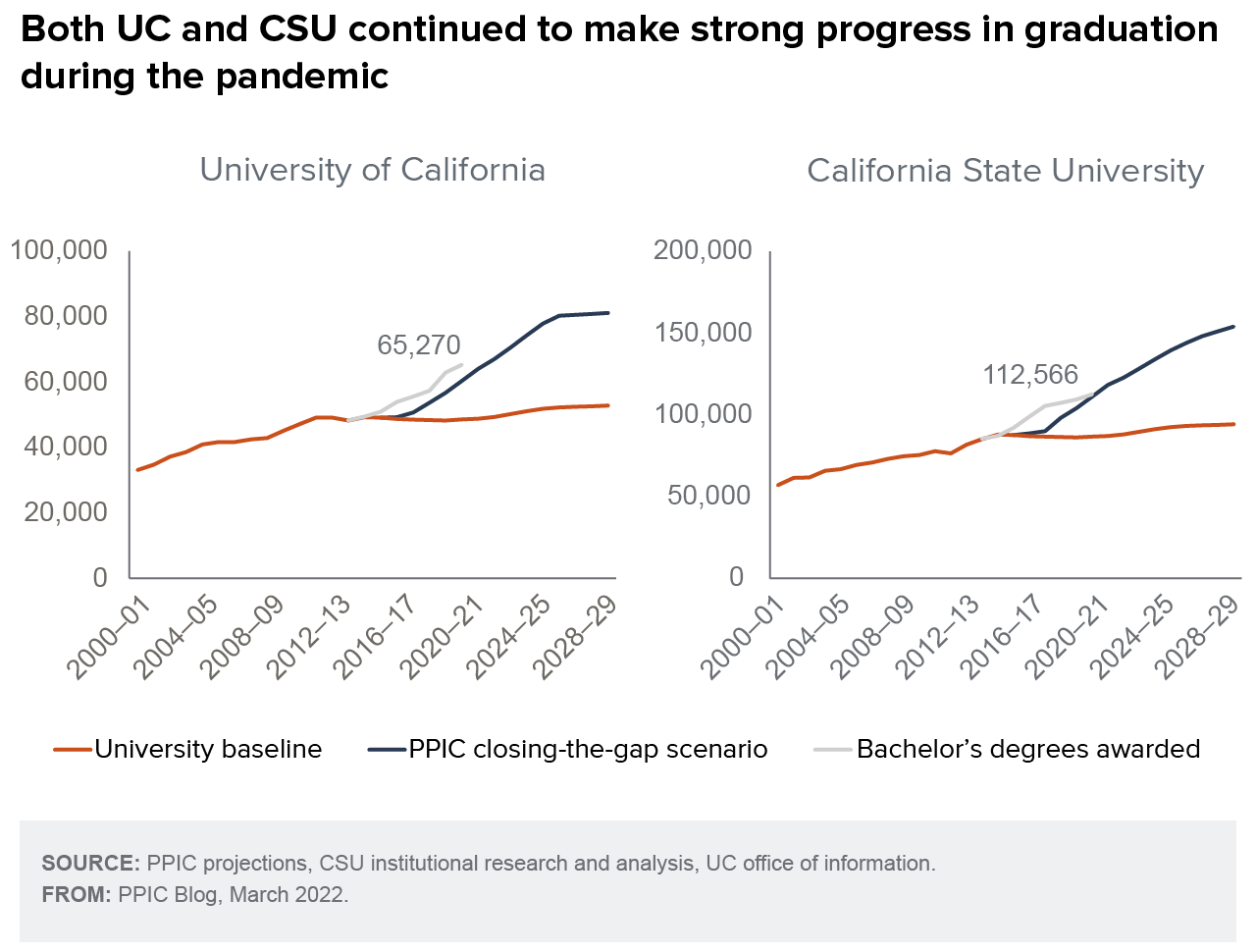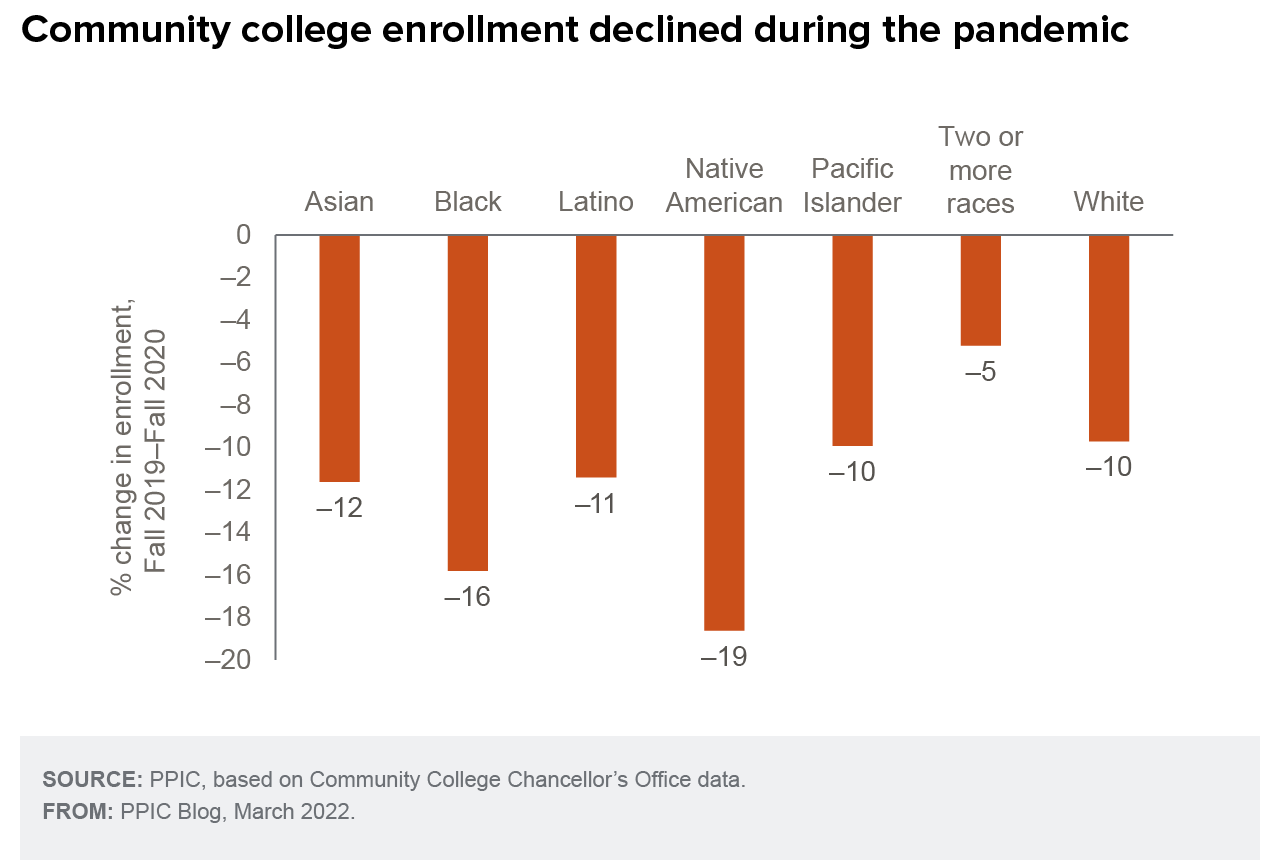This post is part of a series reflecting on California’s experience of the COVID-19 pandemic.
The COVID-19 pandemic led to unprecedented disruptions for California’s college students and the institutions they attend. These disruptions have been wide-ranging, but the effects have not been as severe as initially feared. The rapid delivery of emergency aid from the federal government, along with robust budgets and funding from the state, provided direct support to students and allowed higher education institutions to weather the crisis without significant increases in tuition (as had occurred in earlier economic downturns).
Even so, many students suffered during the pandemic and were unable to start or continue their education. Especially troubling, the past two years have highlighted and exacerbated inequities in access to higher education.
With signs that the endemic phase of the virus is near, the year ahead offers the opportunity to return to some semblance of normalcy. Going forward, a focus on student-centered policies and programs that improve access, completion, and equity in our higher education systems will be critical. And for all the many problems created by the pandemic, it also provided an opportunity to innovate and invest in approaches that are known to work.
The last two years featured several notable highs and lows:
- The degree gap narrowed. Even during the pandemic, the University of California (UC) and the California State University (CSU) continued to make progress in closing the degree gap—that is, reducing a projected shortage of 1.1 million highly educated workers in California. During the last two years, record numbers of students continued to earn bachelor’s degrees. Moreover, applications remained strong throughout the UC system and at most CSU campuses—the elimination of standardized testing likely played a role in increasing and diversifying the pool of applicants. Furthermore, student persistence and completion continued to improve. Both systems are ahead of the goals set by PPIC to ensure an adequate supply of college graduates for our state’s economy. The state’s continued progress is necessary to achieve the governor’s newly announced goal of 70% degree and credential attainment by 2030.

- Community colleges saw challenges and successes. Community college students tend to have fewer economic resources than other college students and were more likely to have been negatively affected by the pandemic. Enrollment declines were larger among students least represented among college graduates, including Black, Native American, and Latino students. Career education (vocational) enrollments fell the most—by 25%, compared to 12% among transfer-intending students. This decline, particularly in career education, points to the unique challenges posed by the pandemic—historically, we have seen community college enrollment increase during economic downturns, but the current tight labor market offers more opportunities than in the past. Moreover, wages for workers without a college education have increased dramatically, making these jobs appealing to young people as an alternative to community college.
Still, understanding and responding to enrollment declines at the community colleges, the state’s largest provider of higher education, is critical to finding ways to re-engage students. The good news is that recent reforms have been tremendously successful in increasing student access to and completion of the introductory English and math courses required to transfer to a four-year college. Even so, persistence rates beyond those courses remain too low. Identifying institutional reforms and student supports (e.g., articulation agreements, guided pathways, and student aid) to help students achieve their academic goals is essential.

- Financial aid for students increased. Over the past two years, colleges and students have received $10 billion in emergency aid from the federal government, and the governor’s budget proposes additional funding for the state’s public colleges. These resources can help address persistent fiscal problems caused by lost revenues and increased expenses related to the pandemic. Given the pandemic’s uneven economic impacts, efforts to simplify, target, and expand the state’s financial aid programs for students with the most financial need will be essential. This year, all high schools in California will be required to show that their graduating seniors have either completed a state or federal financial aid application or have opted out—potentially providing additional resources to students and increasing college enrollment for low-income students and students of color. In addition, new initiatives like dual admission, which would provide a seamless transfer to UC or CSU after completion of lower-division coursework at a community college, could offer cost-effective ways for more students to earn a college degree.
- The cradle-to-career data system made progress. The pandemic highlighted the need to identify how students are faring across education systems. During the past two years, California continued to make progress on establishing a data system that links pre-K, K–12, higher education, workforce, and social services data. Moving quickly to establish a usable data system could provide tools for answering policy questions important to recovering from the pandemic, especially with respect to college access and success.
- Online learning expanded dramatically. The largest and most immediate effect of the pandemic was the move to online learning. Looking ahead, remote instruction is likely to take on a much larger role in higher education than in the past. Identifying the best methods and circumstances for providing online instruction should be a central focus going forward. Ensuring that students have the resources they need—including access to technology—continues to be vital. Other policy and program changes, including flexible scheduling and online student services, would provide further support.
In the coming year, higher education will continue to grapple with providing enough spots for eligible students, supporting student and staff health (including mental health), offering remote instruction and support services, and maintaining fiscal stability. Finding ways to better represent the full diversity of California’s population remains a pressing concern, one that must be addressed if higher education is to meaningfully serve as a driver of educational and economic mobility.
How will the state’s colleges and universities allocate resources to meet these needs and reach the state’s goals? At the PPIC Higher Education Center, we are energized to help find innovative ways to address these challenges—and more—in the weeks and months ahead.
Topics
Access Affordability California Community Colleges California State University career technical education Completion coronavirus COVID-19 enrollment Equity Finance financial aid Higher Education math online learning Population racial disparities transfer Two Years of COVID-19 in California University of California Workforce NeedsLearn More

After COVID, Community Colleges Must Focus on Improving Online Courses

Building California’s Cradle-to-Career Data System

California Remains on Track to Close the Degree Gap

California Sees More College Graduates, but Progress Is Uneven

Dual Enrollment in California






